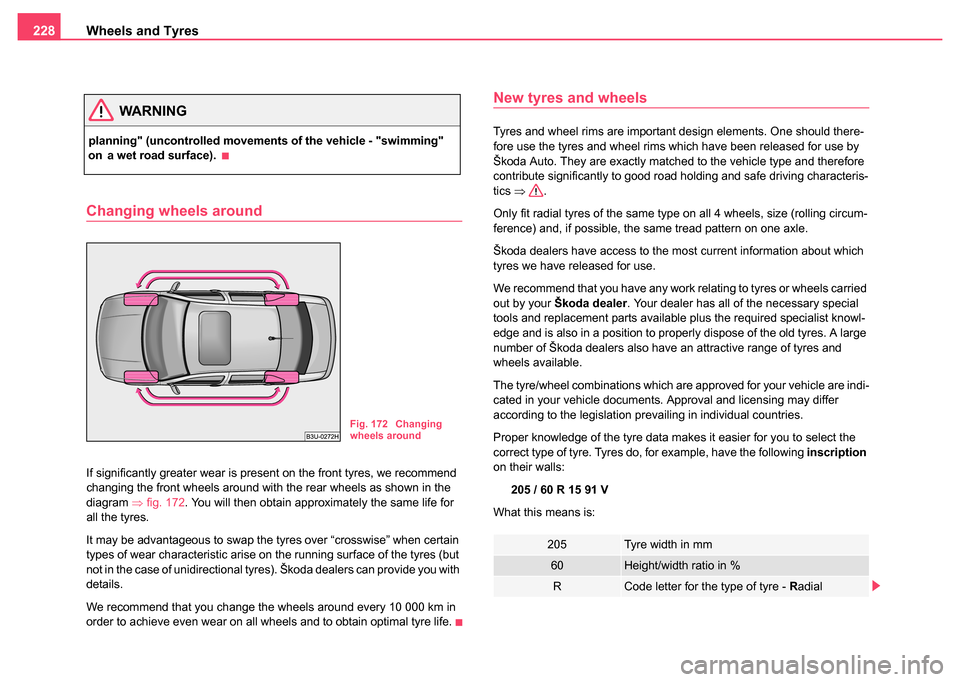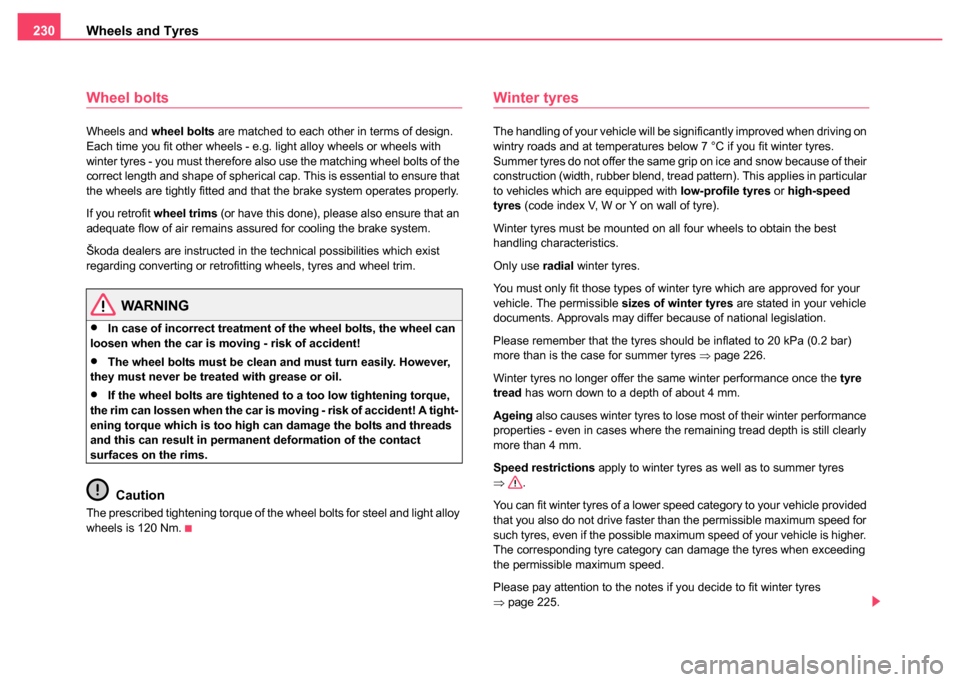width SKODA SUPERB 2004 1.G / (B5/3U) Owner's Manual
[x] Cancel search | Manufacturer: SKODA, Model Year: 2004, Model line: SUPERB, Model: SKODA SUPERB 2004 1.G / (B5/3U)Pages: 270
Page 229 of 270

Wheels and Tyres
228
Changing wheels around
If significantly greater wear is present on the front tyres, we recommend
changing the front wheels around with the rear wheels as shown in the
diagram ⇒fig. 172 . You will then obtain approximately the same life for
all the tyres.
It may be advantageous to swap the tyres over “crosswise” when certain
types of wear characteristic arise on the running surface of the tyres (but
not in the case of unidirectional tyres). Ĺ koda dealers can provide you with
details.
We recommend that you change the wheels around every 10 000 km in
order to achieve even wear on all wheels and to obtain optimal tyre life.
New tyres and wheels
Tyres and wheel rims are important design elements. One should there-
fore use the tyres and wheel rims which have been released for use by
Ĺ koda Auto. They are exactly matched to the vehicle type and therefore
contribute significantly to good road holding and safe driving characteris-
tics ⇒ .
Only fit radial tyres of the same type on all 4 wheels, size (rolling circum-
ference) and, if possible, the same tread pattern on one axle.
Ĺ koda dealers have access to the most current information about which
tyres we have released for use.
We recommend that you have any work relating to tyres or wheels carried
out by your Ĺ koda dealer . Your dealer has all of the necessary special
tools and replacement parts available plus the required specialist knowl-
edge and is also in a position to properly dispose of the old tyres. A large
number of Ĺ koda dealers also have an attractive range of tyres and
wheels available.
The tyre/wheel combinations which are approved for your vehicle are indi-
cated in your vehicle documents. Approval and licensing may differ
according to the legislation prevailing in individual countries.
Proper knowledge of the tyre data makes it easier for you to select the
correct type of tyre. Tyres do, for example, have the following inscription
on their walls:
205 / 60 R 15 91 V
What this means is:
Fig. 172 Changing
wheels around
205Ty r e w i dt h i n m m
60Height/width ratio in %
RCode letter for the type of tyre - Radial
WARNING
planning" (uncontrolled movements of the vehicle - "swimming"
on a wet road surface).
Page 231 of 270

Wheels and Tyres
230
Wheel bolts
Wheels and wheel bolts are matched to each other in terms of design.
Each time you fit other wheels - e.g. light alloy wheels or wheels with
winter tyres - you must therefore also use the matching wheel bolts of the
correct length and shape of spherical cap. This is essential to ensure that
the wheels are tightly fitted and that the brake system operates properly.
If you retrofit wheel trims (or have this done), please also ensure that an
adequate flow of air remains assured for cooling the brake system.
Ĺ koda dealers are instructed in the technical possibilities which exist
regarding converting or retrofitting wheels, tyres and wheel trim.
WARNING
•In case of incorrect treatment of the wheel bolts, the wheel can
loosen when the car is moving - risk of accident!
•The wheel bolts must be clean and must turn easily. However,
they must never be treated with grease or oil.
•If the wheel bolts are tightened to a too low tightening torque,
the rim can lossen when the car is moving - risk of accident! A tight-
ening torque which is too high can damage the bolts and threads
and this can result in perman ent deformation of the contact
surfaces on the rims.
Caution
The prescribed tightening torque of the wheel bolts for steel and light alloy
wheels is 120 Nm.
Winter tyres
The handling of your vehicle will be significantly improved when driving on
wintry roads and at temperatures below 7 °C if you fit winter tyres.
Summer tyres do not offer the same grip on ice and snow because of their
construction (width, rubber blend, tread pattern). This applies in particular
to vehicles which are equipped with low-profile tyres or high-speed
tyres (code index V, W or Y on wall of tyre).
Winter tyres must be mounted on all four wheels to obtain the best
handling characteristics.
Only use radial winter tyres.
You must only fit those types of winter tyre which are approved for your
vehicle. The permissible sizes of winter tyres are stated in your vehicle
documents. Approvals may differ because of national legislation.
Please remember that the tyres should be inflated to 20 kPa (0.2 bar)
more than is the case for summer tyres ⇒page 226.
Winter tyres no longer offer the same winter performance once the tyre
tread has worn down to a depth of about 4 mm.
Ageing also causes winter tyres to lose most of their winter performance
properties - even in cases where the remaining tread depth is still clearly
more than 4 mm.
Speed restrictions apply to winter tyres as well as to summer tyres
⇒ .
You can fit winter tyres of a lower speed category to your vehicle provided
that you also do not drive faster than the permissible maximum speed for
such tyres, even if the possible maximum speed of your vehicle is higher.
The corresponding tyre category can damage the tyres when exceeding
the permissible maximum speed.
Please pay attention to the notes if you decide to fit winter tyres
⇒ page 225.